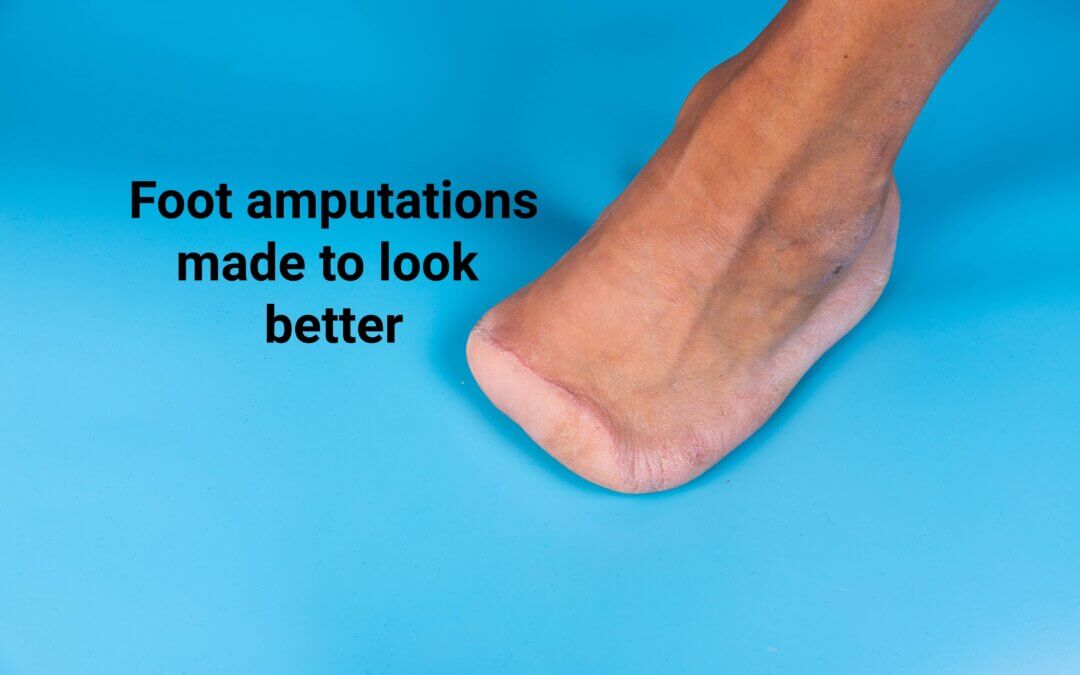The Prosthetic Foot
The number of times a patient walked into my surgery and asked, ‘Can I have a new foot?’ was a common occurrence. Perhaps this is no longer a joke? However, as for the appearance of your foot after amputation? Michael Le-Rouse opens up options here at The Silicone Centre. Most people who experience mild foot problems can cope either by selecting shoes more carefully or just accepting that odd anomaly. However, that odd look could well be due to a forced amputation, and so the problem is much more significant if you cannot overcome self-consciousness.
As a former podiatric surgeon, I came against some patients who were genuinely concerned about how their feet looked. While, for the most part, this might fall to the ladies, it certainly was not exclusive to the female gender. Surgery can offer some solutions, but this comes with risks and sometimes disappointment. I came across Michael Li-Rouse, a specialist in silicone prosthetics and orthotics, and so his article is dedicated to some of the options available. In his article, he will discuss three methods of how crafted silicone can help feet. It is appropriate to advise that, in many cases, this highly technical work is outside traditional NHS provision. Let me introduce you to Michael and his wife, Sarah, both Directors of The Silicone Centre. His story focuses on supporting patients in their anxiety and fears, overcoming self-loathing after living with an abnormality.
The Skilled Prosthetist
Michael’s story covers the subject of your foot after amputation…
It has been 12 years now since I discovered the amazing way silicone can be used to benefit many orthopaedic solutions. The massive growth of social media is making people more aware, but to be honest, I didn’t know much about it until I began my discovery in 2007. Before then, I’d worked as an orthotic/prosthetic technician without realising its beauty. Even now, I see patients who are so amazed it exists and wish they had known about it years ago.
I started my business, ‘The Silicone Centre,’ in 2016 to produce silicone prosthetic/orthotics for all types of limb loss and limb correction. In addition to creating a successful business, through my talent and passion, I would really like to raise awareness and get the message out there to patients and individuals to highlight the life-changing solutions available. I would like to discuss 3 types of Silicone devices that support foot care and provide functionality, comfort, and appearance.
Silicone toe extension
![]()
Your foot after amputation may involve toes, or a more significant part of the foot might be involved. While the bones of the foot are complex, the length of the forefoot is determined by five long bones called metatarsals (see figure above). Under normal circumstances, these develop in such a way that each bone is slightly shorter and smaller than the next (see picture)
A single short metatarsal creates a short toe, and so one solution is to lengthen the metatarsal. While we can do this, there is an option to extend the toe itself. While it can be corrected, there are risks involved, as with any surgery, as well as the patient being left with a noticeable scar. The condition of the shorter bone goes by the fancy name brachymetatarsia or hypoplastic metatarsal. This can affect one or more bones, leaving them abnormally short, so the toes may overlap and be very obviously deformed. Although this condition may result from a congenital defect, it may be an acquired condition. It most frequently involves the fourth metatarsal.
An alternative solution is to use a silicone extension. These silicone toe extensions are made to measure, sculpted with fine detail to appear realistic, and fit well with suction. As a company, during the past 6 months, we have had more requests regarding silicone toes than any other silicone device. It can be life-changing for a person wanting to feel nobody will be drawn into staring at their defect. It helps with self-esteem, and most patients feel they can walk along the beach/poolside barefoot for the first time in a long time.
One of the main benefits is that the patient can feel confident in open-toe shoes, sandals, or flip-flops.
Silicone foot
While accidents might be rare, the majority of amputations across the foot arise due to circulation problems, infection and poorly controlled diabetes. An amputation to the forefoot (metatarsal) or middle part of the foot (midfoot) is often used at each level and has various names, such as Chopart amputation (lower figure).

![]()
A Syme’s amputation (top figure), named after a Scottish surgeon in the 19th century, removed the foot at the level of the ankle. The objective behind these types of amputations is to allow weight bearing on the remaining part of the foot, which means that the person can put weight on the bottom of the foot and be able to walk short distances and stand in the shower without the assistance of a prosthesis. The word prosthesis means an artificial body part. For this reason, and associated with better balance, this type of amputation is advantageous. Unfortunately, because of a congenital condition, disease, or accident, these conditions are more common than they were thought to be.
Silicone for a drop foot
![]()
Silicone is a great way to support foot drop. The best way to describe this is to imagine you cannot lift your foot upwards at the ankle. The drop foot is associated with some muscle weakness, which arises again due to congenital defects often associated with nerves after injuries and may include undesirable effects following surgery. A cast of the ankle and foot is taken and rectified, and the silicone is ready to be applied. Unlike an ankle foot orthosis or A.F.O., the rigid support is applied in silicone across the shin and top of the foot (dorsum). This kind of silicone support is made to measure for maximum support and comfort. It can be worn with or without footwear and even used in water. I made silicone foot drop support for a successful Paralympian, and the results were amazing. Michael says,
“Silicone is a great way to overcome so many solutions.”
Properties & benefits
A silicone foot is both functional and aesthetically appealing. It provides support and can be adapted to support heel raise, arch support, and better joint alignment. The formation of a rocker-like sole and reinforcement of the missing part. It’s made to measure, very durable and can be used in water. The silicone we use can be as soft as a gel to provide comfort for any sore areas. All silicone feet can be made to fit the patient’s footwear, and a gap between the first and second toes can be incorporated to allow for sandals and flip-flops to be worn. Just as important for a lot of patients is the appearance of their feet. The silicone can be sculpted to the finest detail and colour to match the remaining foot. The reality level of finish we offer includes hair, veins, freckles, moles, tendons, detailed nails that can be painted, and tattoos. The finished product is so realistic it is unbelievable to believe that they aren’t real! The positive psychological effect this has on an individual is enormous. However, as there is insufficient evidence of the direct health benefits, these products are not commissioned by the NHS, are only available privately, and can be very costly.
At
The Silicone Centre
we offer a range of finishes to suit every budget, making it affordable for everyone

creating life-like silicone
Thanks for reading ‘Your Foot After Amputation,’ by David R.Tollafield with Michael Li-Rouse
Originally published 2019. Modified January 2025
Busypencilcase Communications & Publications. Est 2015



Recent Comments